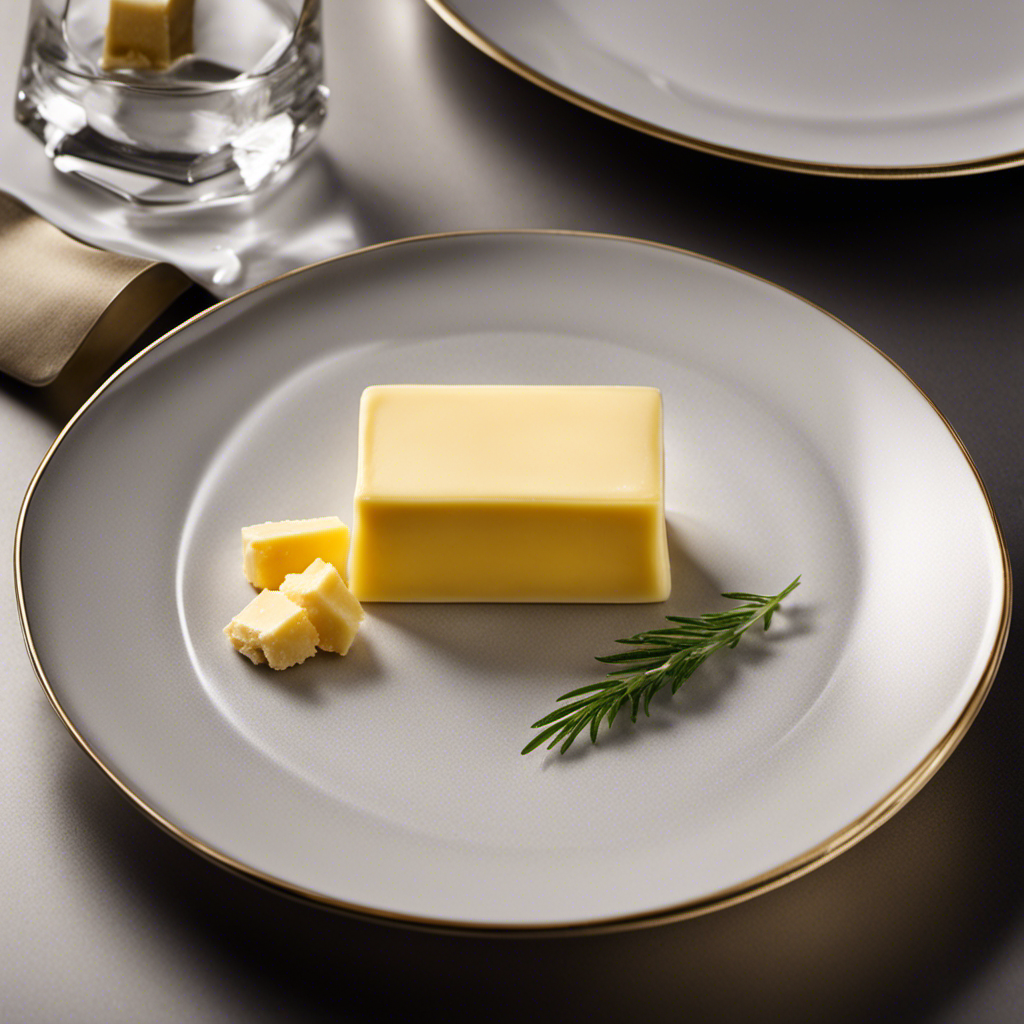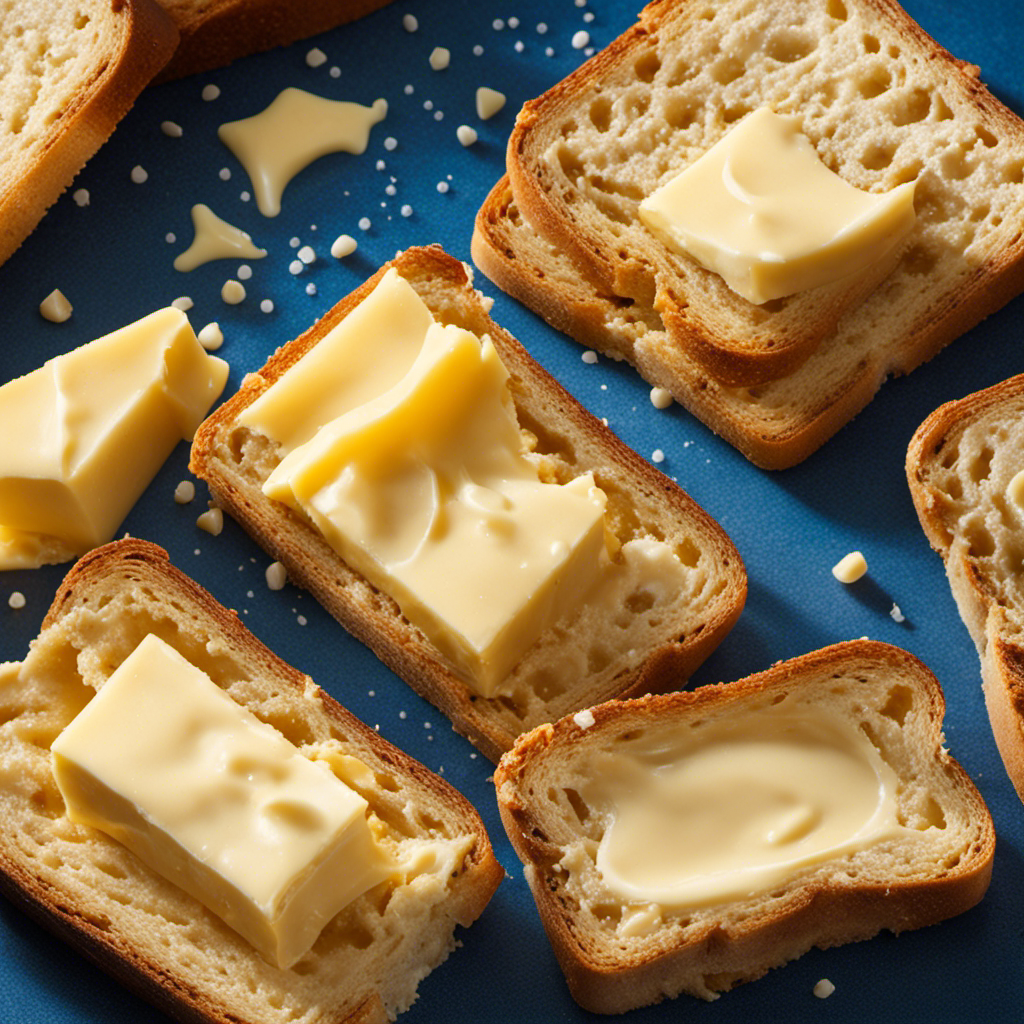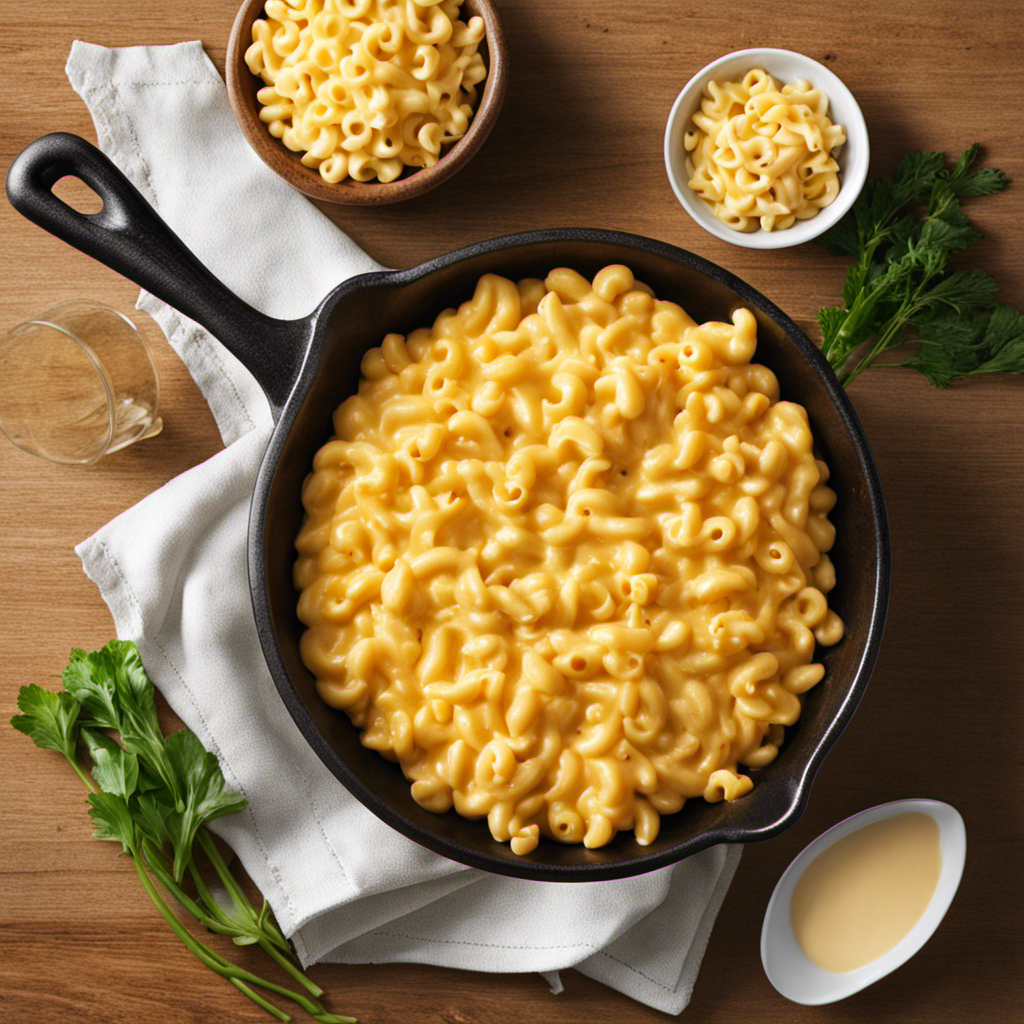I’m no stranger to the kitchen, and when it comes to cooking, precise measurements matter.
Picture this: you’re in the midst of preparing a delicious recipe when it calls for 15g of butter. But how much is that exactly? Don’t worry, I’ve got you covered.
In this article, I’ll break down the conversion rates, explain different packaging options, and even provide some handy equivalents.
So, let’s dive in and demystify the mystery of 15g of butter.
Key Takeaways
- 15 grams of butter is approximately 0.53 ounces.
- Precision is key in baking and cooking.
- Understanding conversion rates ensures accurate measurements.
- Butter equivalents simplify measurements.
Conversion Rates
The conversion rates for grams to ounces can be tricky to remember. When it comes to weight conversion, especially with butter measurements, it’s important to have a clear understanding.
To convert grams to ounces, you need to know that there are 28.35 grams in one ounce. This means that if you have 15 grams of butter, it would be approximately 0.53 ounces. It may seem like a small amount, but when it comes to baking or cooking, precision is key.
Understanding these conversion rates will help you accurately measure and portion out ingredients, ensuring the perfect balance of flavors and textures in your dishes.
Weight Measurement
15 grams of butter is pretty light. When it comes to measuring ingredients, accuracy is crucial. Understanding conversion rates can help ensure that your recipes turn out just right. In the world of cooking, butter equivalents are commonly used to simplify measurements.
For example, if a recipe calls for 15 grams of butter, you can easily convert it to tablespoons or cups depending on your preference. This can be especially helpful if you don’t have a kitchen scale or if you prefer using volume measurements.
Now that we know how much 15 grams of butter weighs, let’s explore the various butter packaging options available and how they can affect your cooking and baking experiences.
Butter Packaging Options
When it comes to butter, there are various sizes available on the market, catering to different needs and preferences. From small individual portions to large family-sized blocks, there’s a butter size for every occasion.
However, as we become more aware of our environmental impact, it’s important to explore eco-friendly packaging alternatives that can help reduce waste and promote sustainability.
Additionally, the issue of single-use packaging concerns arises, highlighting the need for finding solutions that balance convenience with environmental responsibility.
Different Butter Sizes
Butter sizes vary, so it’s important to know how much is in each package. When it comes to buying butter, it’s essential to understand the different sizes available in order to make the right purchase. Here are a few common butter sizes and their corresponding weights:
- Standard stick of butter (4 oz or 113g)
- European butter block (8 oz or 227g)
- Large tub of spreadable butter (16 oz or 454g)
- Family-sized tub of butter (32 oz or 907g)
- Bulk-sized butter for commercial use (5 lbs or 2.27 kg)
Knowing these measurements is crucial for recipe conversions and understanding the weight of butter in different packaging options.
When you have a recipe that calls for a specific weight of butter, you can easily convert it to the appropriate packaging size using these conversion rates. So, next time you’re at the grocery store, consider the different butter sizes available and choose the one that best suits your needs.
Eco-Friendly Packaging Alternatives
Eco-friendly packaging alternatives offer a sustainable option for reducing waste and environmental impact. In today’s world, where plastic waste has become a major concern, finding innovative ways to package products without harming the planet is crucial.
Companies are now turning to eco-friendly packaging solutions that are both practical and environmentally conscious. One such solution is the use of biodegradable materials. These materials, such as plant-based plastics and compostable packaging, break down naturally over time, reducing the amount of waste that ends up in landfills.
Additionally, companies are exploring alternatives to single-use plastic, such as reusable containers and packaging made from recycled materials. By adopting these eco-friendly packaging solutions, we can significantly reduce the amount of plastic waste that is generated and ultimately protect our planet for future generations.
It’s time to rethink our packaging choices and embrace sustainable alternatives. Together, we can make a real difference in reducing plastic waste and preserving the environment.
Single-Use Packaging Concerns
The excessive use of single-use packaging is contributing to the growing problem of plastic waste in our environment. It is alarming to see the amount of single-use plastic that is generated on a daily basis. This issue has a significant environmental impact, as plastic takes hundreds of years to decompose. To fully grasp the severity of this problem, consider the following:
- Single-use plastic is used for a wide range of products, including food and beverage containers, plastic bags, and packaging materials.
- The convenience of single-use packaging has led to its widespread use, but it comes at a cost to our environment.
Plastic waste often ends up in our oceans, causing harm to marine life and ecosystems. Recycling efforts are not sufficient to address the sheer volume of single-use plastic being produced. Sustainable alternatives, such as reusable containers and biodegradable packaging, are available and should be embraced to reduce our reliance on single-use plastic.
It is crucial that we collectively take action to reduce the use of single-use plastic and find more sustainable solutions. Our environment depends on it.
Butter Equivalents
To measure equivalents for butter, you can use charts or online calculators.
But let’s talk about butter alternatives and butter substitutes. With the growing popularity of plant-based diets and dietary restrictions, there are plenty of options available for those who want to avoid or replace butter.
One common alternative is margarine, which is made from vegetable oils and contains less saturated fat than butter.
Another option is coconut oil, which has a similar texture and flavor to butter.
For baking, you can use applesauce or mashed avocado as a substitute for butter.
These alternatives not only provide a healthier option but also add unique flavors to your dishes.
Recipe Adjustments
If you’re following a plant-based diet or have dietary restrictions, there are several recipe adjustments you can make to replace butter. Butter is a common ingredient in baking, but there are other alternatives that can be just as delicious and satisfying.
Here are five recipe modifications you can try:
-
Replace butter with coconut oil: Coconut oil has a similar consistency to butter and adds a subtle coconut flavor to your baked goods.
-
Use mashed avocado: Avocado is rich in healthy fats and can be a great substitute for butter in recipes like brownies or cookies.
-
Try applesauce: Applesauce adds moisture to baked goods and can be used as a replacement for butter in recipes like cakes and muffins.
-
Use nut butters: Almond butter or peanut butter can add a creamy and nutty flavor to your baked goods while replacing the butter.
-
Experiment with vegan butter substitutes: There are many vegan butter substitutes available in stores that are made from plant-based oils and can be used in baking recipes.
Health Considerations
When it comes to health considerations, butter often comes up in discussions about cholesterol and weight gain. Many people wonder about the impact of butter on cholesterol levels and whether it can contribute to weight gain.
Additionally, for those looking for alternatives, there are various butter substitutes available. In this discussion, I will explore the effects of butter on cholesterol and weight, as well as provide information on alternative options for those seeking a healthier choice.
Butter and Cholesterol
You should be aware that butter contains cholesterol, and it’s important to moderate your intake. While many people enjoy the rich and creamy taste of butter, it’s essential to understand the impact it can have on your health. Here are some key points to consider:
-
Butter and heart disease: Consuming high amounts of saturated fat, which is found in butter, can increase your risk of heart disease. It can raise your levels of LDL cholesterol, also known as ‘bad’ cholesterol, which can contribute to the build-up of plaque in your arteries.
-
Butter and diabetes: Butter is high in saturated fat, which can lead to insulin resistance and increase your risk of developing type 2 diabetes. It’s important to choose healthier alternatives, such as olive oil or avocado, which can provide essential nutrients without the negative effects on blood sugar levels.
-
Moderation is key: While butter can be enjoyed in moderation as part of a balanced diet, it’s important not to overindulge. Opt for healthier fats like olive oil or nut butter when possible and limit your consumption of butter to avoid potential health risks.
-
Consider your overall diet: It’s important to look at your overall dietary choices when considering the impact of butter on your health. If you have a diet that is high in unhealthy fats and low in fruits, vegetables, and whole grains, the negative effects of butter can be compounded.
-
Consult with a healthcare professional: If you have specific concerns about how butter may affect your health, it’s always a good idea to consult with a healthcare professional. They can provide personalized advice based on your individual needs and help you make informed decisions about your diet.
Butter and Weight Gain
Consuming excessive amounts of butter can contribute to weight gain due to its high fat content. Butter is a delicious and versatile ingredient that many people enjoy in their daily meals. However, it is important to be mindful of the amount of butter we consume, as it can have a significant impact on our weight.
One tablespoon of butter contains about 100 calories and 11 grams of fat. This high calorie and fat content can easily add up, especially if we use butter generously in cooking or spread it generously on our toast. While butter does have some nutritional value, such as providing essential vitamins and minerals, it is important to moderate our butter consumption to maintain a healthy weight and overall well-being.
Butter Alternatives
If you’re looking for a healthier option, there are several alternatives to butter that you can consider. Here are five butter substitutes that not only taste great but also have some amazing health benefits:
-
Avocado: Creamy and rich, avocado can be used as a spread or in baking. It is packed with heart-healthy monounsaturated fats and is a great source of vitamins and minerals.
-
Greek Yogurt: Replace butter with Greek yogurt in recipes for a tangy twist. It is low in fat and calories and high in protein, calcium, and probiotics.
-
Coconut Oil: With its tropical flavor, coconut oil adds a unique touch to dishes. It contains medium-chain triglycerides, which are easily burned for energy and can help boost metabolism.
-
Olive Oil: Use olive oil as a substitute in cooking and baking. It is rich in monounsaturated fats, which can help lower bad cholesterol levels and reduce the risk of heart disease.
-
Nut Butters: Peanut, almond, or cashew butter can be a delicious alternative to regular butter. They are loaded with healthy fats, protein, and fiber.
Butter Substitutes
Butter substitutes can be a healthier option for those looking to reduce their intake of saturated fats. Not only do they provide a delicious alternative to traditional butter, but they also offer a variety of benefits.
One of the key advantages of butter substitutes is their ability to mimic the taste and texture of butter, making them an excellent choice for baking and cooking. Additionally, many butter substitutes are made from plant-based oils, which are lower in saturated fat and cholesterol. This makes them a great option for individuals with dietary restrictions or those looking to adopt a more plant-based lifestyle.
Furthermore, some butter substitutes come in eco-friendly packaging alternatives, reducing their impact on the environment. So, whether you’re looking to reduce your saturated fat intake or make more environmentally conscious choices, butter substitutes are a fantastic option.
Storing Butter
Storing butter in the refrigerator helps to maintain its freshness and extend its shelf life. Here are some butter storage tips to ensure your butter stays fresh and delicious:
- Keep butter wrapped tightly in its original packaging or transfer it to an airtight container to prevent it from absorbing odors from other foods.
- Store butter on a shelf in the refrigerator, away from the door where temperature fluctuations may occur.
If you won’t be using butter within a month, consider freezing it to prolong its shelf life.
Check for freshness indicators such as a tangy or off smell, changes in color or texture, or the presence of mold.
Remember that butter can absorb flavors from other foods, so avoid storing it near strong-smelling items like onions or garlic.
Frequently Asked Questions
Can I Use Margarine Instead of Butter in a Recipe?
Yes, you can use margarine instead of butter in a recipe. However, keep in mind that margarine may alter the taste of the final product. When substituting in a cake recipe, consider the texture and flavor it will bring.
How Long Can Butter Be Stored in the Refrigerator?
Butter can be stored in the refrigerator for up to four weeks. To properly store butter, keep it wrapped tightly in its original packaging or in an airtight container to prevent it from absorbing odors.
Are There Any Health Benefits to Consuming Butter?
There are health risks associated with consuming butter, such as high cholesterol and saturated fat. However, there are alternatives to butter, like olive oil or avocado, that can be incorporated into a healthier diet.
What Are Some Common Butter Substitutes for Baking?
When it comes to baking, there are many butter alternatives to consider. Vegan options like coconut oil, avocado, and applesauce can be used to achieve similar results. They offer a healthier twist to your favorite recipes.
Are There Any Special Considerations for Using Salted or Unsalted Butter in Recipes?
When it comes to baking, using salted or unsalted butter can make a difference in your recipe. The choice depends on your preference for a slightly salty taste or controlling the salt content.
Conclusion
In conclusion, a mere 15g of butter may seem like a small amount, but its impact in cooking and baking is undeniable.
Just like a tiny spark can ignite a roaring fire, this modest portion of butter can elevate flavors and create mouthwatering dishes.
It’s fascinating how such a small quantity can make a big difference.
So next time you’re measuring out butter for a recipe, remember that even the tiniest amount can have a significant impact on the final result.









